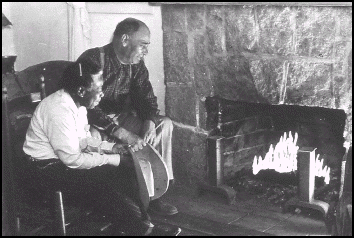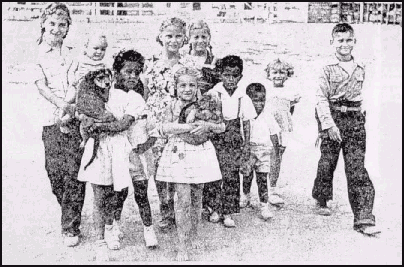

The Cooks, like many of the African-Americans in the Sidewinder/Bell Mountain community, retained their connections in Los Angeles. It was there that they met Nolie and Lela Murray.
Nolie was an industrious man, and in 1914, the year following his marriage to Lela, he began a new business, Murray's Pocket Billiard Emporium and Cigar Store on East Ninth Street in Los Angeles. An article in the Los Angeles California Eagle, dated September 14, 1914, lauds his acumen and ethical conduct in running his establishment:
...[Mr. Murray], owing to sober and investrous habit, honest and just methods of dealing with his many patrons and with an intelligent application to business, has brought to himself a large following of friends and enviable standing with the business world. Murray and his high class way of doing things is indeed a credit to his race. |
Lela was a registered nurse and was just as enterprising as Nolie, but she suffered from frequent colds and respiratory ailments. She and the Cooks were members of the same Los Angeles church, and Arthur Cook knew about her condition and that she wanted to move to the desert for her health.
He offered her, for free, his 40-acre parcel. However, after discussing the matter, it was thought there might be trouble due to inheritance laws, or income tax, or various other property laws, so it was decided that a business transaction would be best. "I wanted the land to be a legal deal," said Lela Murray, "so I insisted on paying Mr. Cook $100 in cash and having it recorded as a bona fide sale. That was in 1922 and I moved up shortly afterwards."
The Murrays hand-dug their first well, which measured some three feet in diameter and 115 feet in depth. This well was later extended to 250 feet. Lack of water was not unusual for the Sidewinder/Bell Mountain area, and many of the homesteaders bought water from town.
Theodore "Ted" Smith, whose family moved to a homestead in the vicinity in 1932, talked about walking to Victor High School, and, when he was lucky, of being able to catch a ride with the water truck. His father's place was about two miles north of Murray's.
He said wells were being sent down 200 to 250 feet, and they couldn't always be dug by hand because of rock. Drilling was an expensive option, but even with an operating well there was an additional problem: no electricity. The large commercial farms had pumps that ran on distillate, or fuel oil, but that was not economical for single-family domestic use. The Murrays, like many others on the desert, solved the problem by installing a windmill with a large water tower.

Nolie continued working in Los Angeles and he would work on the ranch whenever he could. That left Lela to run the operation, which was primarily a chicken ranch.
The Murrays, however, had a dream of creating a better world for underprivileged African- American children, sort of a black "Boys Town," and eventually, many years after acquiring the property, Nolie disposed of the business in Los Angeles and came to the desert to work full-time on the project.
It would take a lot of hard work and some lucky breaks, but by the end of the 1930s the ranch would boast about 20 buildings, a swimming pool, tennis courts, stables, dining hall, and a ball diamond — and all of it fenced. Of course, the ranch did not have all of these amenities at first, but the Murrays and the children had plenty to keep them busy.

The ranch catered to youngsters who were in trouble, either because of their own misdeeds or through problems at home. These children were sent to the ranch by the courts. Other youths at the ranch might be suffering from health problems, especially lung ailments such as asthma or tuberculosis.
Regardless of why the children were there, each one was assigned chores, and if the duties were not completed, the youngster would be taken to task by Nolie. But stern disciplinary measures were not often needed, as Nolie was a big personable character and the children were anxious to please him. His trips into town were memorable events for them. He went from store to store gathering supplies, followed by a large entourage of youngsters of various ages. Each would be carrying a share of the bundles that Nolie hauled back for Lela's kitchen at the ranch.
The Murrays worked diligently at the ranch, but nevertheless they began to have financial problems; the continued depression threatened ruin. Income from the youngsters' care was nominal, and Nolie and Lela were having trouble making expenses.
They began converting the place to a dude ranch, in hopes of paying their debts and saving the youth home, but time was running out. Bills in town were adding up. The outlook had become very gloomy when an unexpected event changed everything.
 PAGE
1|
2|
3|
4|
5|
6|
7|
8|
9|
10|
11|
12|
13|
14
PAGE
1|
2|
3|
4|
5|
6|
7|
8|
9|
10|
11|
12|
13|
14


